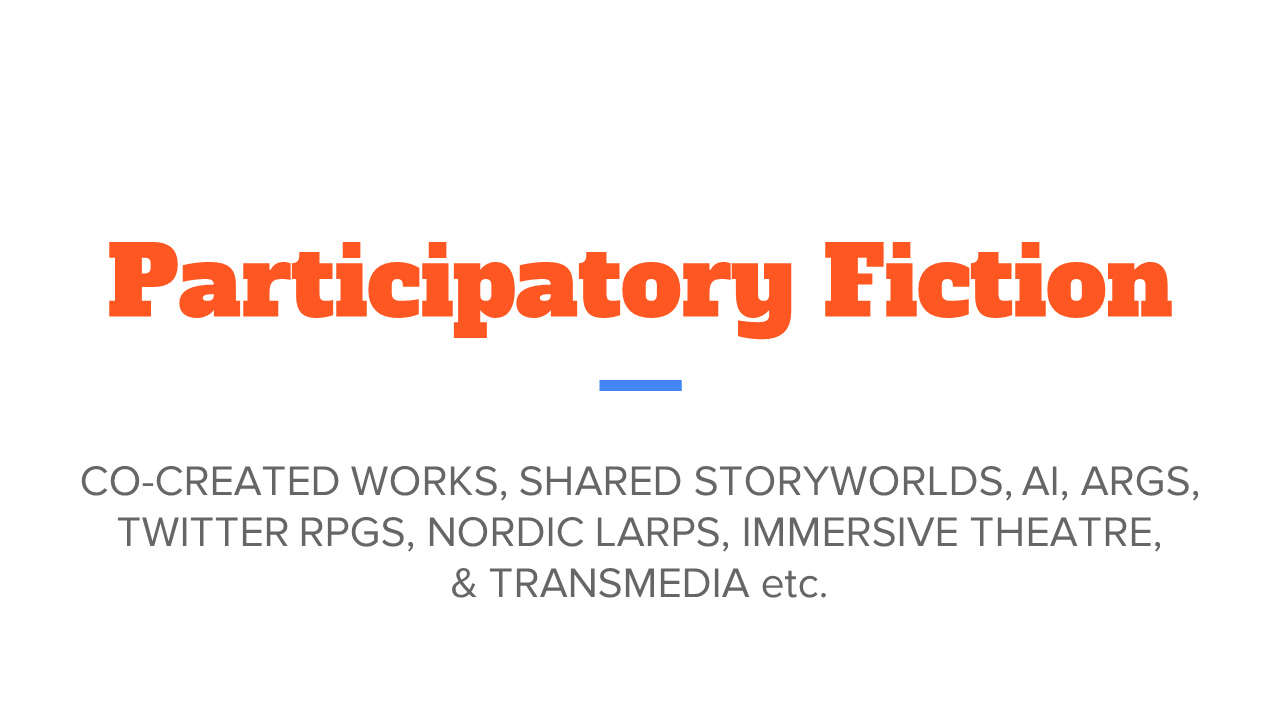Here is an updated version of Carrie’s presentation on Participatory Fiction for an upcoming guest lecture at Lillian Allen’s Experimental Fiction class at OCAD University. You may download the powerpoint presentation which contains the talking points. Further notes and resources are available below.
PRIMER
Story was once uncontained, it was pervasive, immersive, interactive, participatory, co-created, in a shared storyworld (and in many cultures it still is) through multiple media: performance, text, architecture, etc.
To contain a story was a radical idea, experimental… ‘the novel was so radical’ it was well novel, new. The early novelists were experimenting with form borrowing from conventions of reality (note: both are linear):
- collection of letters in sequence
- serialized distribution
Transmedia is actually a return, a renewal of uncontained narrative. Trans means across and beyond, so transmedia means across and beyond media to tell a whole story that crosses multiple media channels (text, film, live events, etc.) in which vital narrative aspects might be missed if media components are not consumed on their individual discreet platform, and often the participants/audience/users inform the narrative somehow by their active participation.
GLOSSARY WITH RESOURCES
INTERACTIVE
Users/audience makes choices to wayfind their way through the narrative.
- ZORK
- Interactive Fiction: http://twinery.org/
- Choose Your Own Adventure novels
- Interactive Film: Netflix’s Bandersnatch
- To Be or Not To Be: A Chooseable Path Adventure
- Visual/Kinesthetic Novels
IMMERSIVE
Usera/audience are embedded inside the storyworld as self or character
- video games
- VR and AR
- Alternate Reality Games (ARGs)
- Immersive Theatre: Sleep No More
- Experiences: Westworld Experience
- Nordic Larp: Inside Hamilton
PARTICIPATORY
Users participate beyond making choices predetermined pathways by author
- DND & RPGS
- zed.to/byologyc
- Resistance Radio (unintentional participation?)
PERVASIVE
Always accessible, moving in real time
- Meatspace (live events)
- websites
- ARGS and AR games
- MMORPGs
- twitter RPGS — Welcome to Sanditon
CO-CREATED
A collaboration between authors/participants or participants/participants based on constraints and facilitation
- DND/RPGS
- This ‘Gay Island’ tumblr post (unintentional)
- Welcome to Sanditon
- Cthalloween
- SXStarWars: http://jaybushman.com/SXStarWars-2010-The-Empire-Tweets-Back and http://jaybushman.com/SXStarWars-2009-Twitter-Trench-Run
SHARED STORYWORLDS
A world that has been built by an author/creator(s) that participants are invited to co-create with them either by explicit invitation or implicit permission (fan fiction)
- sandbox model
- Welcome to Nightvale (unintentional shared storyworld)
- Clockwork Watch
UGC (User-generated content)
Any media item that the audience shares into the campaign or narrative
RABBIT HOLE
Any entry point into the narrative whether it be online content (a video, gif, blogpost, news item, etc.) or in meatspace (a poster, a t-shirt, etc.) that lures someone into the storyworld
LINKS TO ADDITIONAL RESOURCES
SHARED STORYWORLDS
ALTERNATE REALITY GAMES
TRANSMEDIA
All of Storyforward Podcast; check this episode on twitter storytelling; and episodes featuring Brian Clark
Michael Monello (Blair Witch/Campfire): Babies Buns and Buzzers slideshare
Brian Clark’s Phenomenology keynote
Trevor Haldenby’s dissertation on Byologyc/Zed.TO
TMC Resource kit: (case studies galore)
Simon Staffans’s site — a current podcast/blog
